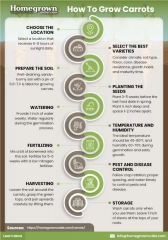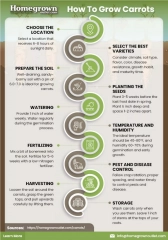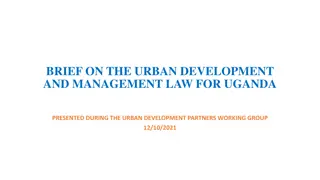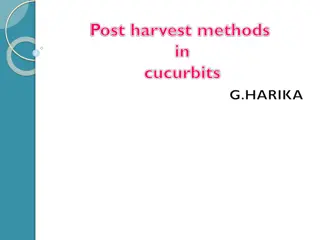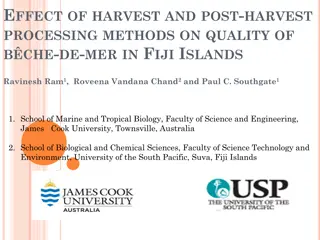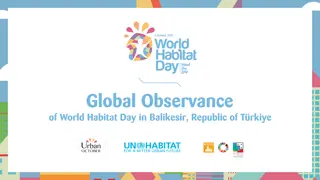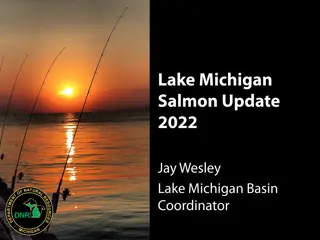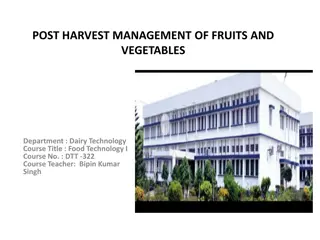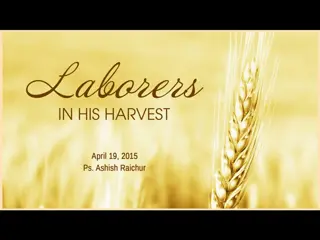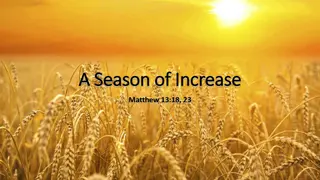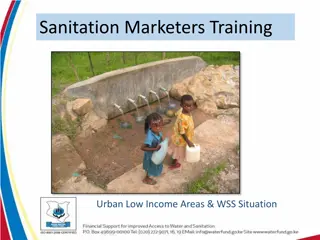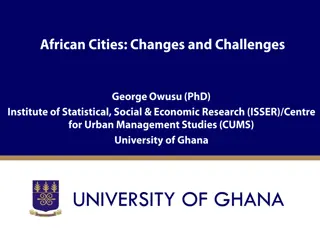Cultivating Community Engagement Through Urban Harvest Today
Bob Randall, Ph.D., discusses Urban Harvest's impact on community engagement and provides valuable insights on effective organizational design, shared at the Annual Longwood Graduate Symposium.
- Community engagement
- Urban Harvest
- Organizational design
- Longwood Graduate Symposium
- Urban gardening
Download Presentation

Please find below an Image/Link to download the presentation.
The content on the website is provided AS IS for your information and personal use only. It may not be sold, licensed, or shared on other websites without obtaining consent from the author. Download presentation by click this link. If you encounter any issues during the download, it is possible that the publisher has removed the file from their server.
E N D
Presentation Transcript
Bob Randall, Ph.D. www.urbanharvest.org YearRoundGardening@comcast.net 713-661-9737 Branching Out: Cultivating Community Engagement, Annual Longwood Graduate Symposium March 6th, 2009
Urban Harvest Today Templates for effective organizational design Spreading contagious ideas Building a horticultural school system Non-profit strategic planning to increase numbers of supporters Using land design templates to plan organizational work loads and goals
How do you engage people in growing nature s bounty?
400 People have provided five years or more of service
Urban Harvest, together with its predecessor group, started 22 years ago. It tries to service Houston and its metropolitan area with many types of horticultural support. Houston is the nation s fourth largest city (2.2 million people) and its metro area has 5.7 million residents, so this is ambitious There are about 100 other groups in the metro area supporting environmental efforts as well.
Urban Harvest builds communities through food gardens, landscapes and farms By teaching youth, and both novice and professional adults. UHI does this by supporting community and school gardens; By sponsoring gardening classes and workshops; By managing an annual fruit tree sale, a weekly farmers market, and an organic landscapers education effort.
Such work improves the quality of life in the greater Houston area. It educates, strengthens community spirit, creates therapeutic environments, and provides both food and income. This work benefits everyone by improving food, diet and health. It also builds engaging schools, neighborly communities, & valuable local businesses. These together sustain and improve our environment.
Community Food Gardens School Gardens & Outdoor Classrooms Education in Sustainable Horticulture Market Gardening & Farming
Community gardens are any neighborhood based effort by an institution or group of households to use horticulture to improve the community. In the Houston area, these have been mostly efforts to grow food. Historically, Houston s first community gardening non-profit with staff started in 1987.
Most community gardens have a main purpose such as: Providing food for the gardeners. Donating food to a food pantry, soup kitchen or shelter. Educating adults or youth about ecology, food gardening or market growing. Providing opportunities for therapy and rehabilitation, or efforts to enable; or Simply making the neighborhood more of a community.
Building Community & Improving One s Diet
Outdoor classrooms have one or more of these design elements: vegetables, fruits, habitat, animals, recycling, enterprise. They must be in synch with curriculum. Houston s largest school district pays UHI to put gardening and habitat instructors in 19 low income schools See video and information at www.urbanharvest.org/programs/schoolyou th/index.html
Three of the first four community gardens we built failed the next year and all had failed by year eight. The first seven homeless shelter gardens all failed. Only 3 of 12 urban low-income vacant lot efforts that started before 2000 lasted more than a few years. All school gardens started before 1996 failed, though two we didn t start remain.
Some gardens built between 1988 and 1998 prospered, so we gradually learned how to make different types of projects work. And the failures of the first decade helped create a much better success rate during the last decade in schools, on vacant lots, and in the inner city. *
Modest Beginnings First 3 Failed in 8 months 4th Failed in 7 years 3 on right are still going
In areas with urban poverty, most institutions (like shelters and community action agencies) have insufficient staff to manage a labor-intensive garden. Vacant lot gardens without institutional support often have difficulty with staffing within 5-10 years. This is because the original leadership usually has health or other personal problems and they recruit poorly.
In low income areas, Houston schools generally have land and many staff, so they are often the best places to put gardens; In the Sun Belt, the best weather and best time to be outdoors is during the school year. But principals and teachers are accountable for curriculum based education results, so successful gardens at schools must have education and curriculum as the main focus, not diet, habitat, gardening, or recycling.
Suburban donation gardens at churches often work well. Park gardens are great provided there is adequate investment, support, and an opportunity for gardener self- management.
The Community & School Gardens Programs: Some Lessons Learned A solid garden team of five unrelated, committed adults that meet regularly and have institutional support is highly desirable. Community gardener wannabes that go through a three class How to Start a Community or School Garden sequence have much, MUCH higher success rates.
Review goals and prioritize what the garden will feature and do. Review how to organize volunteers. Review how to get funding. Provide an overview of vegetables you can grow & gardening education.
Review each proposals progress getting volunteers, funds, and setting priorities. Work on site selection criteria and practice selecting a site. Draw garden on paper. Review fruits you can grow and fruit growing education opportunities available.
Work on modifying designs that participants bring. Work on scheduling materials deliveries and organizing build dates. Practice laying out your design at your site. Review construction and survey the tools needed for building day. Discuss maintaining a site. Review habitat plantings that grow well in the Houston area.
Written & electronic publications Classes Permaculture design curriculum Annual fruit tree sale Organic Landscaping Education for Professionals (OHBA) Weekly Sunday column in Houston s daily newspaper
Popular Gardening Books by Staff
People flock to a low cost series of classes at convenient times (weekends or weekday nights twice monthly). About 75 different classes per year. Popular: 15 hour Basics of Gardening; 25 hour Growing Organic Vegetables; 25 hour Building Your Backyard Orchard; and Habitat Gardening Classes are a great place to recruit volunteers and board members.
110 green industry businesses pay $500-600 per year for dinner speakers every two months.
This year the sale grossed $135,000 in just 3 hours on sales of 6000 highly adapted fruit trees! Held at Rice University Stadium (site of Super Bowl VII) Net of about $57,000. Probably could have sold twice as much. Used 180 different people doing 308 different described tasks. **
UHI has been teaching the 72 hour permaculture designer s curriculum since 1996. Permaculture was founded by Australian Bill Mollison in the early 1970 s. It is an effort to create sustainable societies by dramatically reducing materials, energy and labor in all human endeavors. It is based partly on the careful study of forest ecology and its healthy functioning. It tries to duplicate this sustainability in human designs and plans.
We teach it mostly on weekends in the city, but do hands-on education out-of-town four times a year A fall class on The Permaculture Of Bountiful Gardens; a winter class on Greening Our Homes and Communities; a spring class on Restoring Nature; and a graduation project. A high proportion of graduates Get It . They go on to change Houston and many become outstanding volunteers and staff.
True farmers markets sell Mostly farm products, That are produced less than 150 miles away, By the market vender s family or employer. This eliminates competition from much lower cost labor and land in distant places so farmers can survive economically. Ag labor is paid 94 cents per hour 7 hours south of Houston in Mexico.
Houston lost its last true farmers market in the 1930 s. UHI spent 14 years trying out ideas, making mistakes, and researching other successful markets (such as New Orleans), before we developed a viable one. A farmer with a very modest investment can net $12-25 per hour. By contrast, local feed- corn agriculture with major investment in land and machinery nets only $25 per acre per year.
Farms & Market Gardens
In logic or mathematics, a heuristic is a helpful procedure for arriving at a solution to a problem. Cognitive scientists note that if one can make an apt comparison between a difficult problem and a familiar problem, a good solution can frequently be found. More generally, one of the most powerful heuristics for solving a difficult problem is the conscious use of reasoning by analogy.
Mendeleyev used an analogy with the ranks and suits of playing cards in solitaire to create the periodic table of elements. Researchers trying to create synthetic paintbrush bristles only succeeded when they realized boar s hair bristles behave like pumps.


